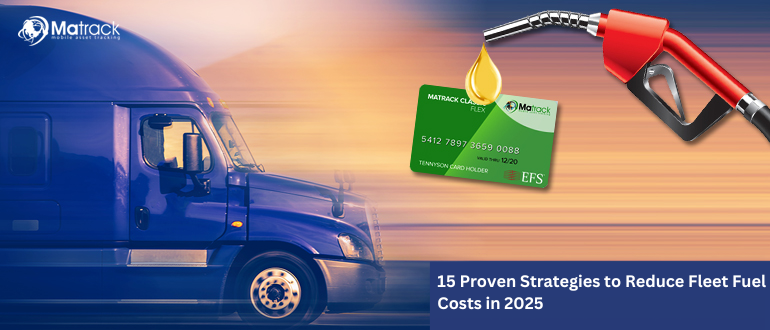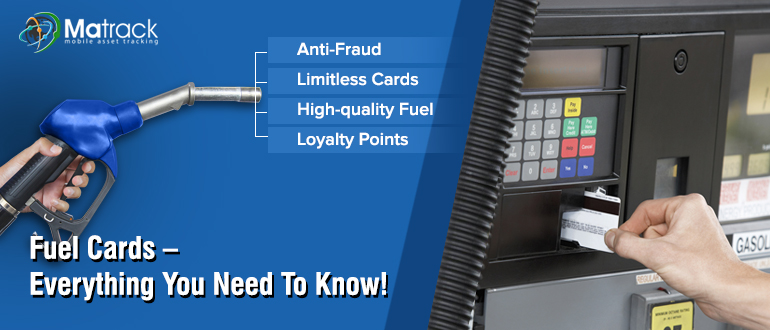Key Takeaways:
- A vehicle fuel monitoring system tracks fuel levels, fuel consumption, and refueling in real-time using sensors, telematics, and software.
- Main features like fuel theft detection, driver behavior tracking, and GPS integration reduce fuel waste and strengthen operational control.
- Types such as capacitive, ultrasonic, flow meter, and OBD-based systems match different vehicle types and fuel management needs.
- Matrack Fleet Fuel Card is the best overall option by combining cost savings, wide fuel station acceptance, and advanced tracking tools.
What is a Vehicle Fuel Monitoring System?
A vehicle fuel monitoring system is a smart combination of hardware and software that tracks how much fuel a vehicle uses. It gives accurate, real-time information about fuel levels and consumption.
Sensors and telematics devices installed in the vehicle collect fuel data as the vehicle operates. This data gets sent automatically to a central online platform for easy access.
Reports and alerts help fleet managers and vehicle owners spot fuel theft, track refueling, and improve fuel use. Fuel data becomes a powerful tool for cutting costs and boosting efficiency.
Related: What is a Fuel Management System?
What are the Main Features of a Vehicle Fuel Monitoring System?
A vehicle fuel monitoring system offers features that provide accurate fuel tracking, theft prevention, and fuel efficiency improvement. These features give full control over fuel management in real-time.
- Real-time fuel level tracking: records exact fuel levels at any moment during vehicle operation.
- Fuel consumption reporting: provides detailed data on how much fuel is used over specific distances or time periods.
- Fuel theft detection: triggers instant alerts when sudden fuel loss happens, helping stop unauthorized fuel siphoning.
- Refueling event logging: tracks where, when, and how much fuel is added during each refueling.
- GPS integration with fuel data: links fuel usage to vehicle location for complete fuel route analysis.
- Driver behavior monitoring: connects fuel use with driving actions like idling or harsh acceleration.
- Custom notifications: deliver email or SMS alerts when fuel data shows abnormal patterns.
Also see: What Is A Driver Monitoring System?
Types of Vehicle Fuel Monitoring Systems
Capacitive Fuel Sensor System
Capacitive fuel sensor system measures fuel level by detecting changes in electrical capacitance inside the tank. Capacitive fuel sensor system delivers high accuracy, making it reliable for trucks, buses, and fleet vehicles where precise fuel data matters.
Ultrasonic Fuel Sensor System
Ultrasonic fuel sensor system measures fuel level using sound waves that reflect off the fuel surface. Ultrasonic fuel sensor system is a smart choice for vehicles carrying hazardous or sensitive fuels because it does not touch the fuel directly.
Flow Meter-Based System
Flow meter-based system records the exact amount of fuel flowing through the fuel line on its way to the engine. Flow meter-based system suits construction machinery, mining equipment, and other heavy-duty vehicles where accurate flow data is critical.
OBD-Based System
OBD-based system calculates fuel consumption by reading data from the vehicle’s onboard diagnostics port. OBD-based systems work well in modern cars and vans where a quick, sensor-free solution is preferred.
Benefits of a Vehicle Fuel Monitoring System
Fuel Cost Reduction
Fuel cost reduction happens by spotting fuel inefficiencies and stopping fuel theft. This benefit helps lower operational costs and improves long-term profitability.
Enhanced Operational Control
Enhanced operational control comes from having clear, detailed fuel consumption data. Managers gain the insight needed to plan, budget, and maintain vehicles more effectively.
Fuel Theft Prevention
Fuel theft prevention works through real-time alerts and precise tracking of fuel levels. This makes it harder for unauthorized fuel siphoning to go unnoticed.
Improved Route Planning
Improved route planning combines fuel data with GPS location information. The result is smarter routing that cuts fuel consumption and saves time.
Reduced Environmental Impact
Reduced environmental impact is achieved by minimizing fuel waste and lowering emissions. This supports sustainability targets and meets regulatory standards.
Driver Accountability
Driver accountability increases when fuel use is linked to specific driving behavior. This encourages drivers to operate vehicles more responsibly.
Compliance Support
Compliance support comes from having accurate, organized fuel records ready for audits or tax filings. This saves time and prevents reporting errors.
How to Install a Vehicle Fuel Monitoring System?
Assess Vehicle Requirements
Assess vehicle requirements by checking the fuel tank size, fuel type, and vehicle model. This helps you choose the right system for your operational needs.
Select Appropriate Fuel Sensors
Select appropriate fuel sensors based on the level of accuracy you need. Capacitive, ultrasonic, flow meter, or OBD-based sensors suit different vehicle types and applications.
Install Sensors Securely
Install sensors securely by following manufacturer instructions for positioning and mounting. Correct installation inside the fuel tank or on fuel lines ensures accurate readings.
Connect Telematics Device
Connect telematics devices to the sensors and vehicle’s electrical system. Make sure the device can transmit fuel data without interruption.
Configure Fleet Management Software
Configure fleet management software by setting up dashboards, reports, and alerts. This lets you monitor fuel data easily and take action when needed.
What Is The Best Vehicle Fuel Monitoring System?
Matrack Fleet Fuel Card is the best overall option for vehicle fuel monitoring because it combines cost savings, control, and flexibility. Fleet operators benefit from live fuel pricing updates, purchase tracking, and automated fuel cost management in one platform.
Fleets save at least $2,000 per vehicle each year by using this card to find the cheapest fuel stations and secure discounts of up to 50 cents per gallon. With acceptance at 95% of fuel stations across the U.S., drivers can refuel almost anywhere without hassle.
Advanced features like spending limits, GPS-linked reporting, and real-time purchase alerts give managers full visibility and control over fuel expenses. The system also simplifies IFTA tax reporting, cutting down on paperwork and reducing errors during tax filing.



